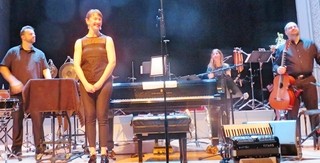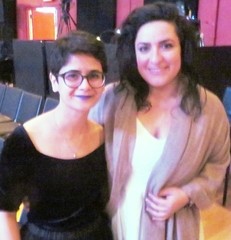|
Back
Cries and Whispers from an Ancient Dream New York
Roulette Intermedium
04/03/2019 -
Iranian Female Composers Association “Another Birth”
Aida Shirazi: Tide
Anahita Abbasi: Moving SurfacesIII/Another Birth
Niloufar Nourbakhsh: FIXED
Farzia Fallah: In the Empty Echo
Mahdis Golzar Kashani: Heaven has no prayer niche but love
Nilofar Habibian: Something to Be Said
Hypercube Ensemble: Erin Rogers (Saxophones), Jay Sorce (Classical and Electric Guitars), Andrea Lodge (Piano, Accordion), Chris Graham (Percussion)

C. Graham, A. Lodge, E. Rogers, J. Sorce (© Samuel A.Dog)
“I want to sing like the birds sing, not worrying about who hears or what they think.”
Jalāl ad-Dīn Muhammad Rūmī (1207-1273)
“A line is a dot that went for a walk”
Paul Klee (1879-1940)
Strolling over the border from Turkey into Iran was–many decades ago–leaving an army camp, entering an art museum. From Turkey’s heavily policed cities with statues commemorating great military heroes, this young traveler entered towns with byways named after Persian poets–Ferdowsi Avenue, Havez Street, with sculptures immortalizing ancient artists, with cities like Shiraz noted more for its roses than its conquests, with schoolchildren inviting me to hear the –literally–breathless Persian sounds of ancient verses.
Yes, after all these years, I naively idealize a country which was under a fearful dictator. And the Iran of today is hardly that of my augmented memories. Still, films coming out of Iran, with their metaphorical images are marvelously imaginative. And as I heard last night, the music from the improbably named Iranian Female Composers Association (IFCA) has its own singular delights.
True, the six composers are living abroad, mainly in America. And true, only a single work had references to Persian classical music. Yet this was music that was consistently poetic, that flew through the air of Roulette Concert Hall like the figures of Paul Klee or Joan Miró.
Perhaps it was more the work of pointillistic painters than composers, but was beguiling nonetheless. And IFCA were especially fortunate to have their notes transformed into sound by the Hypercube Ensemble. Piano, saxophone, percussion and guitars.
Chris Graham’s percussion showed the IFCA imagination at work. More than snare drums and bass drums, Mr. Graham worked with two bunches of shrubbery which he manipulated like marionettes. He and pianist Andrea Lodge clapped wooden sticks a quarter-tone apart, Australian bull-roarers, a vibraphone and Ms. Lodge’s accordion.
That should sound like a lot of noise in the Roulette Concert Hall, but rarely was the volume raised. Perhaps it was my imagination, but the fragments, the cells, the disconnected notes were as cryptic as Sufi maxims.

A. Shirazi, N.Habibian (© Samuel A.Dog)
The opening, Tide by the young Aida Shirazi was for solo piano, and Ms. Lodge used, minimally, all the percussive operations of the instruments. though it was a soft percussion. The piano wires inside the box, tonal clusters on top and bottom of the scale. The connections were beyond my ken, yet one heard a grace, a kind of inner rhythm which was oh so appealing,
Mixed Surfaces III/Another Birth was more complex, yet the instruments (and vegetation of the shrubbery) were never loud. Erin Rogers’ tenor sax was hardly the sound of the instrument. It was mostly breathing through the mouthpiece. The bull-roarer, usually used to augment sound, here was less the original Outback whistling, than a keening, a dark sound next to the piano and sax. Again, I precluded construction in order to find the poetry.
Niloufar Nourbakhsh’s FIXED (the only non-New York premiere) was easy to decipher. One electronic note was behind Ms. Lodge’s piano. Both piano and sound crescendoed up and then, as one would expect, became a soft diminuendo, after the piano imitated the electronic sound. What was she playing? It was original, but the piano sounds were Rachmaninoff rhapsodizing, a music far far away in time and space.
In the Empty Echo used the entire Hypercube Ensemble, but the music was again hardly more than a whisper. It was beguiling. The music never soared, but it floated, the treble inchoate figures, with vibraphone and single high notes from guitar or sax, floating like clouds with momentary lightning from soft drums.
The last work, Something to Be Said perhaps didn’t have that much to be said. A few tones from the accordion, temporarily going into fortissimo clusters with equally loud drum and sax. Instead, it depended on visual arm gestures: vertical from piano, horizontal from sax, finger-wagging from guitar, two arms stretched high from percussion. The semaphores were cryptic to me, but not unappealing. And if reminiscent of New York Happenings a half century ago, well, so be it.
My favorite–for personal reasons–was the penultimate Heaven has no prayer niche but love by Mahdis Golzar Kashani. The message was puzzling but the sounds were vaguely familiar. First, the piano strumming coming out of De Falla, vaguely Iberian but implying a nocturnal desert sound. Or that wonderful dream-painting by Henri Rousseau, The Sleeping Gypsy.
The second standout was the only reference to Persian music itself. Ms. Rogers whole-tone melodies which I had heard over and over again in the villages of Iran. They were, in fact, the only references to the Iranian music, and that was a shame. Not that these six composers were under a rule to compose music going back to their ancestral roots. Yet, in this lovely concert, one wished for less the abstract tone-painting of Europe and America, and more the reveries, even the vibrations from an ancient empire which (outside of a battle or two with Greece) might well have ruled the world.
Harry Rolnick
|